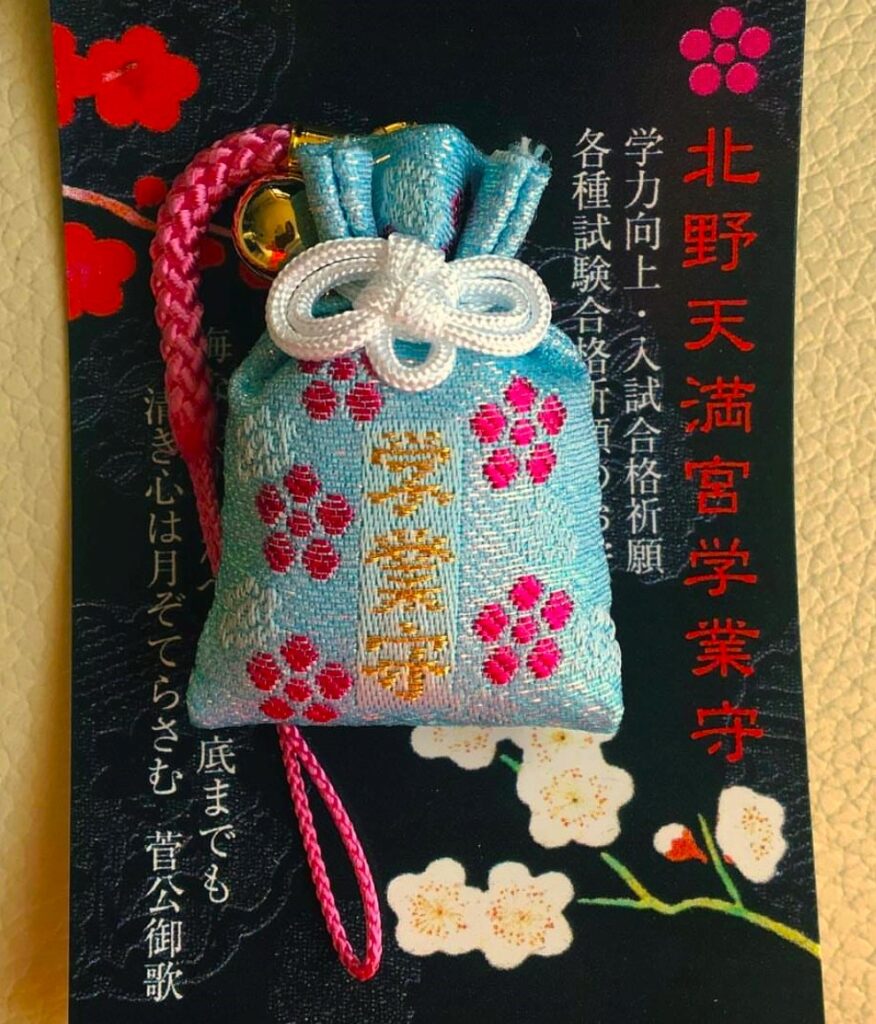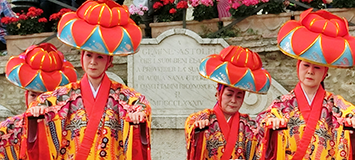SAMURAI BUILD 2F,
1-29 Katori-cho, Nakamura-ku,
Nagoya, Aichi Prefecture, Japan
KITANO TENMANGŪ SHRINE AND ITS SYMBOLISM THROUGHOUT HISTORY, ANIME CULTURE AND MORE!

KAMISHICHIKEN DISTRICT: The most traditional area in Kyoto
Kamishichiken is one of the five and the oldest licensed Hanamachi (Geisha District) in Kyoto and it is located in the Nishijin area, in the northwest part of the City where there is also the famous Kitano Tenmangu Shrine. Moreover, Kamishichiken is a great place to see machiya (tea houses), in fact, it literally means “Seven Upper Houses” referring to the seven teahouses built for Toyotomi Hideyoshi.
Here you can enjoy a relaxing and quiet atmosphere and, if you are lucky, also experience an encounter with a geisha.
Kamishichiken is also well known for its textile production Nishijin-ori such as silk brocade fabric or l hand-woven textiles.
Kamishichiken district’s Kitano Odori is an annual large-scale elegant dance performed both by geisha and maiko. It is held from late March to early April, an event not to be missed in spring!
KITANO TENMANGŪ SHRINE: The Shrine of Sugawara no Michizane, the God of Studies
The Kitano Tenmangu Shrine is located in the northwest part of Kyoto, near the famous Kinkakuji and this is the first Shrine in Japan to have enshrined as a Deity an actual person: Sugawara no Michizane.
Sugawara no Michizane is associated with Tenjin (Shinto God), the God of education and academic and, this is why, nowadays, Kitano Tenmangu Shrine is considered to be a pilgrimage site for many students who come here to pray for success in their entrance examinations and studies.

SUGAWARA NO MICHIZANE: A POET WHO BECAME THE DEITY OF SCHOLARSHIP
Sugawara no Michizane was not only an excellent poet, but also a remarkable scholar and politician of the Heian Period (794-1185) as well as an adviser to emperors Uda and then Daigo.

Moreover, he is best remembered for his skill at composing Kanshi Chinese poetry, in fact Michizane also took part in receiving delegations from the Kingdom of Parhae (actual North-east China area) where his skill with Chinese proved useful diplomatic and poetry exchanges.
Unfortunately, he fell into disgrace with the Fujiwara Clan since he was falsely accused of plotting against the throne and then transferred to Dazaifu in Fukuoka (Kyūshū Island), where he died.
THE CONSTRUCTION AND THE STRUCTURE OF KITANO TENMANGU SHRINE
After his death, a lot of disasters struck Kyoto such as fires and earthquakes and these were attributed to Sugawara no Michizane`s revenge. In order to placate his vengeful ghost, his spirit was deified and finally Kitano Tenmangu Shrine was built in his honour in 947AD even though the actual structure was constructed by Toyotomi Hideyori in 1607 AD.
Let’s visit Kitano Tenmangu Shrine with us!
The impressive stone Ichi no Torii Gate at the entrance of Kitano Tenmangu. The Komainu (lion dogs) placed at the both sides of Kitano Tenmangu’s gate are the biggest in Kyoto.
Passing through the gate, a wide stone paved path flanked by stone lanterns will lead you to a second stone torii gate, smaller than the one at the main entrance.

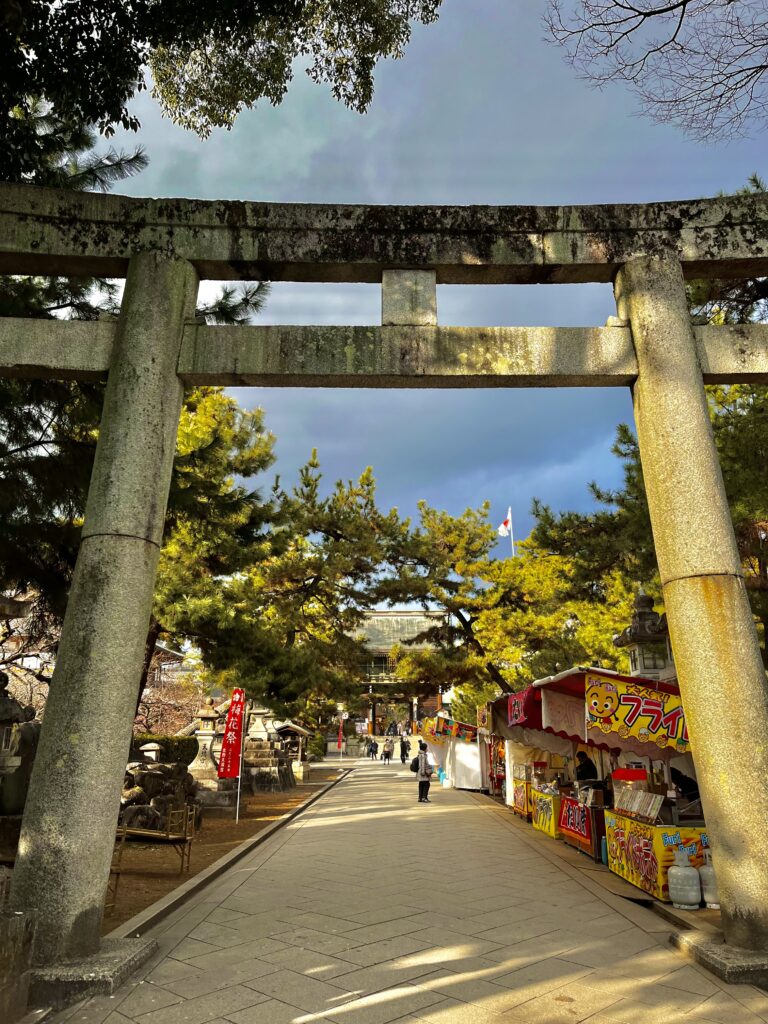
Two ornate gates preceed the main part of the Shrine: Romon Gate and Sankomon Gate (1573 AD – 1603 AD). As they were built in the same time, they both reflect perfectly the architecture of the Momoyama Period with their golden decorations and vivid colors.



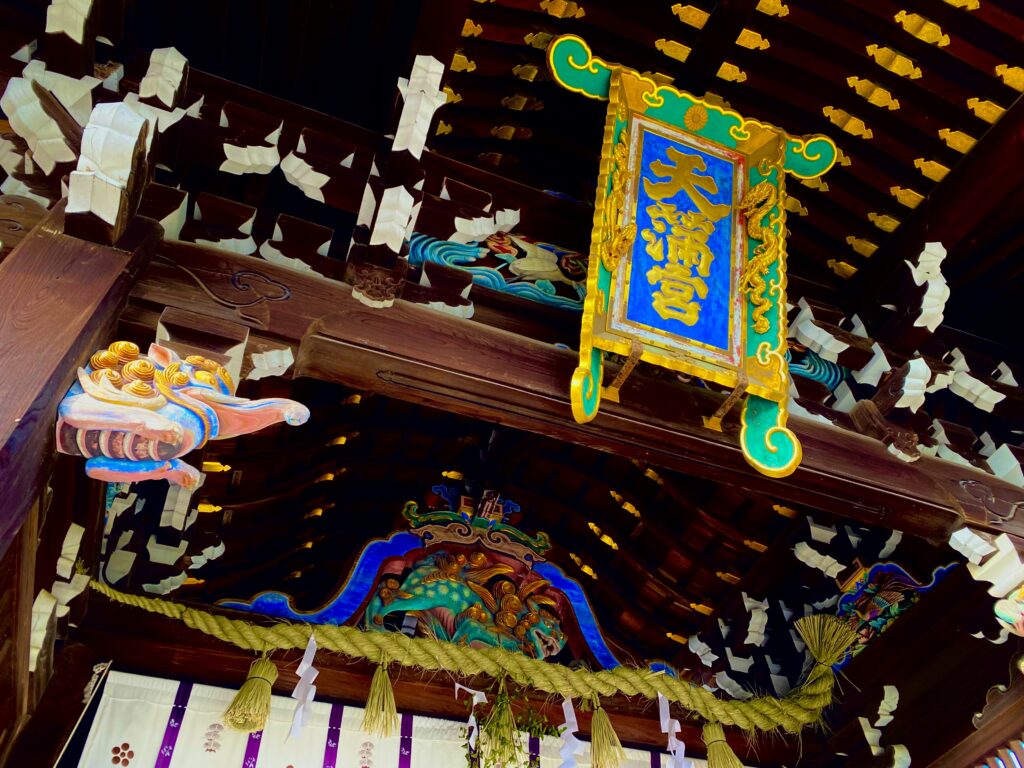

Once you go through the Sankomon Gate, you will see the “Haiden” (Worship Hall), unfortunately the Honden (Main Hall) is not visible since it is thought to be too sacred for anyone to look in, even the priest are not allowed inside the Honden.

The architecture of Kitano Tenmangu Shrine is unique and different from the other Shrines because it consists of a lot of structures under the same cypress roof. The Honden and the Haiden are connected through a short path called “Ishi no ma”. Moreover, two small rooms “Raku no ma” are located on each side of the Haiden on a raised floor.
When visiting Kitano Tenmangu Shrine, do not forget to pray also at the “Ura no Yashiro” Shrine, a Shrine behind the Honden that enshrines Michizane`s ancestors: his father and grand father.


In front of Ura no Yashiro and the Honden there are small auxiliary shrines called Setsumatsusha, entrusted to the care of the larger Shrine, in this case the Kitano Tenmangu one.

Next to Setsumatsusha, there are vermilion colored torii gates leading to three cow sheds where nowadays are hang Ema. Ema are wooden wishing plaques in which worshippers write their prayers or wishes at a Shintō shrine in Japan.


THE OX: THE SYMBOL OF SUGAWARA NO MICHIZANE
Another symbol of Kitano Tenmangu Shrine is the ox, considered a sacred animal messenger.
According to a legend, the ox that was pulling the poet`s funeral cart, suddenly stopped moving forward and sat down. This was interpretated as a sign that Michizane wished to rest there, in Dazaifu Tenmangu Shrine (Fukuoka).
Moreover, it is said that Michizane was born and died in the year of the Ox.
Kitano Tenmangu Shrine is the home to several statues of various oxes called Nade Ushi (rubbing cows) in different sizes and materials, people rub their head for good luck and relief from pains.


“Hanachozu“ : a beautiful floral art
Did you know that when visiting a Shinto Shrine, visitors are required to purify themselves by washing their hands and rinsing their mouth with pure water before praying to Gods. Recently, in Japan many Shinto Shrines transform their water basin into beautiful and colorful floral art called Hanachozu.
At Kitano Tenmangu Shrine you can enjoy a view of seasonal and unique flowers floating on the top of the water. These flower arrangements have become very popular in the wake of Covid-19.

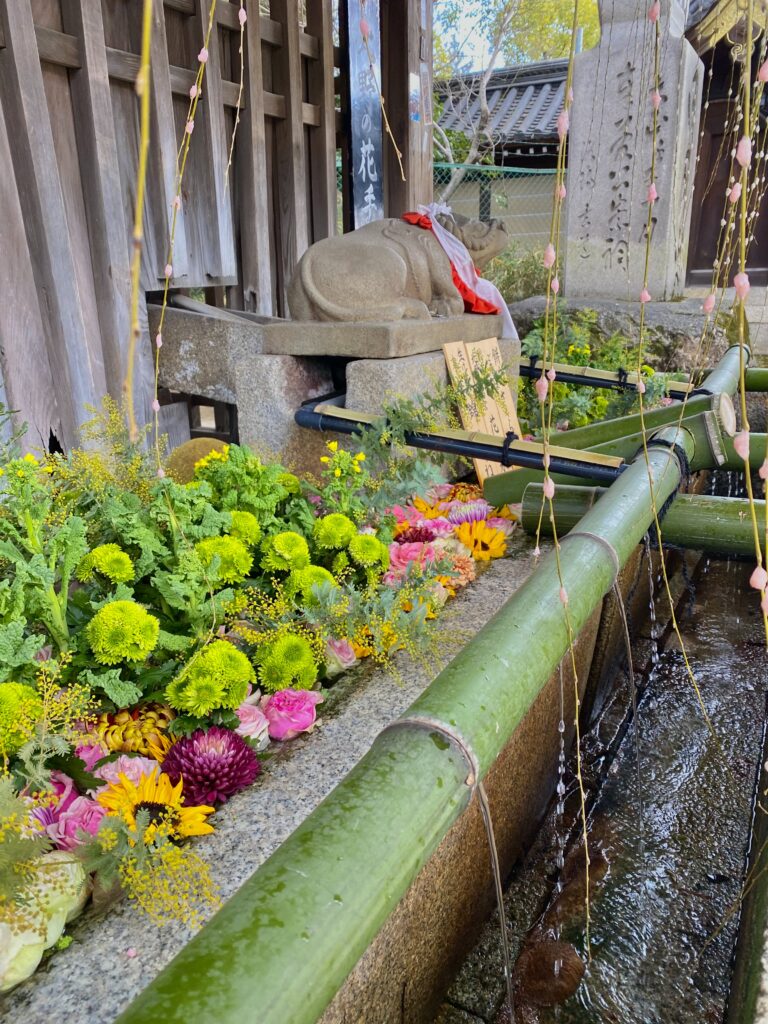
MICHIZANE’S BELOVED PLUM TREES
Did you know that in Japan plum blossoms symbolize vitality and renewal? They are the first flowers that bloom when winter is still in the air and, at the same time, they remind us that spring is around the corner. Kitano Tenmangu Shrine is famous for its gorgeous plum blossoms, which bloom from the beginning of February to the end of March. Today in Kitano Tenmangu Shrine’s garden there are over 1.500 plum trees and over 50 different species in white, pink and red.


Sugawara no Michizane’s favorite flower is plum blossom and he loved plum trees since the young age. Therefore, when was forced to leave Kyoto, he was so sad that he bade farewell to his favorite plum trees writing a poem where he wished them to continue blossoming also during his absence.
Plum blossoms are also the design of Kitano Tenmangu’s Omamori (good luck charm) for studies.
THE “TENJIN-SAN” FLEA MARKET
Sugawara no Michizane was born and died on the 25th, this is why the “Tenjin-san” flea market is held on the 25th of every month. More than 1000 stalls are lined up in the area around the shrines, you can experience the culture of the local Japanese flea market: second-hand kimonos, antiques, toys, bonsai and all kind of tools and food such as yakisoba, karaage and takoyaki.
Moreover, on February 25th of each year is celebrated the famous Baikasai(梅花祭), the plum blossom festival, in order to commemorate the poet Michizane. “Baikasai” is an outdoor-tea ceremony performed by Kamishichikenn District Geisha apprentices with over 3000 guests!
KITANO TENMANGU SHRINE IN ANIME CULTURE
Did you know that Kitano Tenmangu Shrine and Sugawara no Michizane appear in the anime and manga Noragami?



東風吹かば
にほひをこせよ 梅の花
主なしとて
春を忘るな
Kochi fukaba
Nioi okose yo Ume no hana
Aruji nashi tote
Haru o wasuru na
When the east wind blows,
flourish in full bloom, you plum blossoms!
Even though you lose your master don’t be oblivious to spring.
In Noragami, Michizane makes his first appeareance in Noragami Ep. 3 by reciting the poem above, a poem dedicated to his beloved plum trees before leaving Kyoto.


In the manga, it is also interesting and funny to see his repulsion towards the Fujiwara Clan who exiled Michizane to Dazaifu in Fukuoka.










